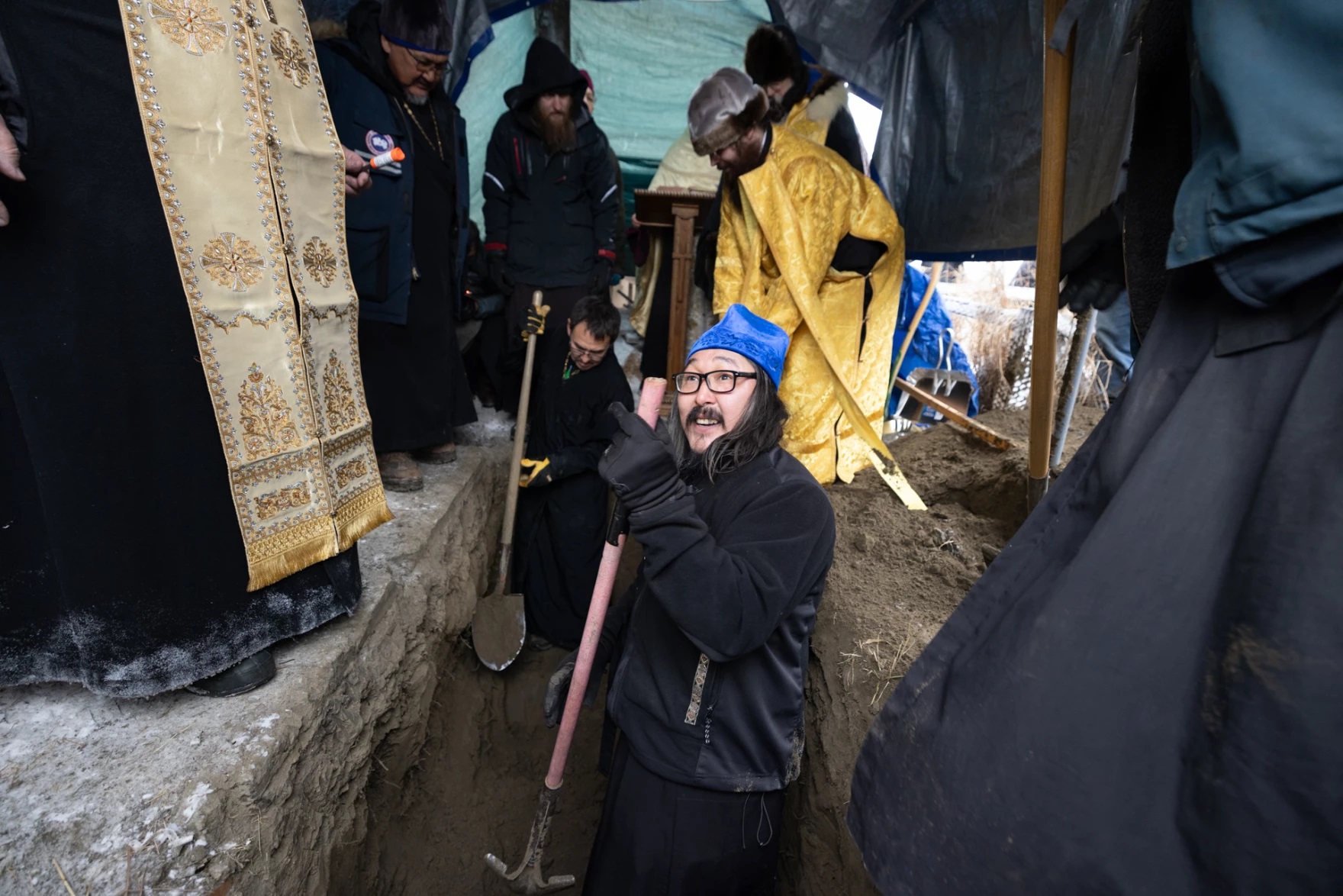In Kwethluk, the relics of the first-ever Yup’ik saint are unearthed
Description
<figure class="aligncenter size-full">
 <figcaption class="wp-element-caption">Fr. Michael Nicholai pauses to offer the shovel to another clergyman while uncovering the grave of Matushka Olga during the process of her exhumation in Kwethluk on Nov. 16, 2024. (Courtesy Katie Baldwin Basile)</figcaption></figure>
<figcaption class="wp-element-caption">Fr. Michael Nicholai pauses to offer the shovel to another clergyman while uncovering the grave of Matushka Olga during the process of her exhumation in Kwethluk on Nov. 16, 2024. (Courtesy Katie Baldwin Basile)</figcaption></figure><figure class="wp-block-audio"></figure>
Puffs of feathery snow drifted among the crowd gathered at the cemetery of the St. Nicholas Orthodox Church in Kwethluk on a bitter cold Saturday in mid-November. Clergy, Kwethluk residents and people from as far away as Eastern Europe stood packed between the tight rows of graves, while dogs weaved through the crowd. The people sang a final blessing to St. Olga of Alaska before the task at hand began.
“We’re going to begin now the process of uncovering the relic of a saint,” said Bishop Alexei, the head of the Russian Orthodox Diocese of Sitka and Alaska, wearing a heavy fur-lined robe and holding a golden crozier topped with two serpents.
Bishop Alexei traveled to Kwethluk alongside clergy from across the state. With the blessing of Orthodox faithful from the region, the church is completing the next step in making Olinka “Arrsamquq” Michael, or Matushka Olga, the first female Orthodox saint in North America, and the first-ever Yup’ik saint.
“All of us, I think, must ask in our heart that holy Matushka Olga will help us, will bless us to do this thing which is not done anywhere,” Alexei said.
<figure class="aligncenter size-full">
 <figcaption class="wp-element-caption">Fr. Nicholai Larson (third from left) advises his fellow clergymen to dig safely so no one is hurt during the process of uncovering Matushka Olga in Kwethluk on Nov. 16, 2024. (Courtesy Katie Baldwin Basile)</figcaption></figure>
<figcaption class="wp-element-caption">Fr. Nicholai Larson (third from left) advises his fellow clergymen to dig safely so no one is hurt during the process of uncovering Matushka Olga in Kwethluk on Nov. 16, 2024. (Courtesy Katie Baldwin Basile)</figcaption></figure>Half a dozen priests huddled under a tarped enclosure and drove steel bars into the frozen tundra where St. Olga was laid to rest 45 years ago. The ground quickly began to crack and peel away to reveal soft, sandy soil that the mid-November frost hadn’t yet touched.
For the entire, hours-long exhumation process, clergy took turns continuously chanting from the Gospels, the biblical account of the life and teachings of Jesus. Others kept a constant supply of incense and charcoal burning, which wafted through the crowd and over the growing hole.
<figure class="aligncenter size-full">
 <figcaption class="wp-element-caption">Orthodox disciples from up and down the Kuskokwim and as far away as Slovakia watch as the remains of Olinka Arrsamquq Michael, known as Matushka Olga, are unearthed over several hours in Kwethluk on Nov. 16, 2024. (Courtesy Katie Baldwin Basile)</figcaption></figure>
<figcaption class="wp-element-caption">Orthodox disciples from up and down the Kuskokwim and as far away as Slovakia watch as the remains of Olinka Arrsamquq Michael, known as Matushka Olga, are unearthed over several hours in Kwethluk on Nov. 16, 2024. (Courtesy Katie Baldwin Basile)</figcaption></figure>St. Olga’s granddaughter, Margaret Michael, stood placidly as the pile of dirt grew next to the grave. She said it’s an honor to see her grandmother made a saint, and to hear faraway accounts of her healing powers after her death. But Michael said, for her, St. Olga simply represents the strength and compassion of Yup’ik culture.
“For the most part, Yup’ik people are like how she was. So I thought of her, like, as a normal human being until those people started dreaming about her,” Michael said.
At the graveside, dirt from the grave was carefully packed into Ziploc bags, which were distributed through the crowd and tucked into backpacks and coats. The holy soil will be used as a tool for healing among the people that fill the cemetery and their congregations back home.
It’s been more than 50 years since a saint’s remains were exhumed in Alaska, but soil from St. Herman’s resting place on Spruce Island near Kodiak is still used in the same healing way today.
<figure class="aligncenter size-full">
 <figcaption class="wp-element-caption">Members of the clergy and Orthodox disciples gather in the cemetery in Kwethluk to exhume the body of Matushka Olga, a step toward her official glorification as a saint, on Nov. 16, 2024. (Katie Baldwin Basile) </figcaption></figure>
<figcaption class="wp-element-caption">Members of the clergy and Orthodox disciples gather in the cemetery in Kwethluk to exhume the body of Matushka Olga, a step toward her official glorification as a saint, on Nov. 16, 2024. (Katie Baldwin Basile) </figcaption></figure><figure class="aligncenter size-full">
 <figcaption class="wp-element-caption">Constantine Saclarides, who traveled to Kwethluk from Anchorage, assists with the uncovering of Matushka Olga’s grave on Nov. 16, 2024. (Katie Baldwin Basile)</figcaption></figure>
<figcaption class="wp-element-caption">Constantine Saclarides, who traveled to Kwethluk from Anchorage, assists with the uncovering of Matushka Olga’s grave on Nov. 16, 2024. (Katie Baldwin Basile)</figcaption></figure><figure class="aligncenter size-full">
 <figcaption class="wp-element-caption">Dirt from Matushka Olga’s grave, a holy relic to Orthodox disciples that will be used for healing and ceremonial purposes, is carefully packed and distributed throughout the crowd during her exhumation in Kwethluk on Nov. 16, 2024. (Courtesy Katie Baldwin Basile)</figcaption></figure>
<figcaption class="wp-element-caption">Dirt from Matushka Olga’s grave, a holy relic to Orthodox disciples that will be used for healing and ceremonial purposes, is carefully packed and distributed throughout the crowd during her exhumation in Kwethluk on Nov. 16, 2024. (Courtesy Katie Baldwin Basile)</figcaption></figure>At one end of the growing pile, Zoya Ayapan gathered up soil. She said she be




